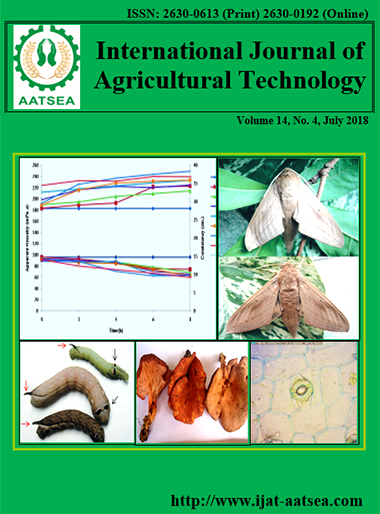Mentha and Citrus oil against Post Harvest Deterioration of Wheat during Storage
Main Article Content
Abstract
Severe deterioration of wheat seeds were taken by different mycotoxin producing fungi as well as insects during its storage and for control of such post harvest losses and several synthetic chemicals are commonly used. But the use of many synthetic chemicals has been cautioned due to their residual toxicity, carcinogenicity, teratogenicity and other adverse effects on different biological system of animals and human beings after consumption. In this attempts were made to study the efficacy of Mentha and Citrus oil against post harvest management of stored wheat. Out of 08 fungi isolated from stored wheat sample, Aspergillus flavus was found most dominant, and followed by Aspergillus niger and Aspergillus fumigatus. These mycoflora were treated with different concentration of Mentha and Citrus oils. 500 and 1000µl/ml of Mentha and citrus oil respectively, which found effective against them. The effect of these two oils were also affected to two insects Sitophilus oryzae and Tribolium castaneum which commonly associated with stored wheat samples. It was found that at 50 0µl/ml concentration of Mentha oil and at 1000µl/ml concentration of Citrus oil, infestation of stored wheat samples with insects was completely checked. Seeds of wheat exhibited significantly increasing in percent germination after storage that was provided with fumigation by both the oils, which inoculated by fungi.
Article Details

This work is licensed under a Creative Commons Attribution-NonCommercial-NoDerivatives 4.0 International License.
References
Agrawal, G. P., Thakur, M. K. and Awasthy, S. (1980). Studies on the wheat grain storage in Madhya Pradesh "Fungi associated with different varieties of freshly harvested wheat gains". National Academy Science Letters 3:195-197.
Agrawal, D. (2003). Evaluation of some plant products in protection of some fruits from fungal rotting. (Doctor of Philosophy’s Thesis). Purvanchal Univ., Jaunpur, U.P., India.
Amritesh, C. S. (2013). Plant secondary metabolites as source of postharvest disease management: An overview. Journal of Stored Products and Postharvest Research 4:1- 10.
Azam, K. M., Harthy, S. A., Razvi, S. A. and Ali, A. A. (1994). Relative toxicity of certain insecticides against Tribolium castaneum (H.), Sitophilus oryzae (L.) and Callosobruchus maculatus. (F.) Pestology 18:10-12.
Cauvain, S. P. (2003). Breadmaking. Cambridge: Woodhead Publishing.
Dhaliwal, G. S. and Arora, R. (2001). Integrated Pest Management: Concepts and Approaches. New Delhi: Kalyani Publishers.
Founder, S. (1968). Practical mycology. Manual for identification of fungi. New York & Kingston: Hafuer publishing Company Inc.
Isman MB. (2006). Botanical insecticides, deterrents, and repellents in modern agriculture and an increasingly regulated world. Annual Review of Entomology 51:45-66.
Kumar, D. and Kalita, P. (2017). Reducing Postharvest Losses during Storage of Grain Crops to Strengthen Food Security in Developing Countries. Foods 6:8. Retrieved from doi:10.3390/foods6010008.
Kumar, P., Yadava, RK., Gollen, B., Kumar, S., Verma, RK. and Yadav, S. (2011). Nutritional Contents and Medicinal Properties of Wheat: A Review. Life Sciences and Medicine Research 2011: LSMR-22.
Liu. C. H., Mishra, A. K., He, B. and Tan, R. X. (2001a). Composition and antifungal activity of essential oils from Artemisia princeps and Cinnamomum camphora. International Pest Control 47:72-74.
Liu. C. H., Mishra, A. K., He, B. and Tan, R. X. (2001b). Antimicrobial activities of isoalantolactone a major sesquiterpene lactone of Inula racemosa. Chinese Science Bulletin 46:498-501.
Mishra, A. K., Liu, C. H., He, B and Tan, R. X. (2000). Efficacy of isoalantolactone a sesquiterpene lactone from Inula racemosa as herbal fungitoxicant to control Take-all disease of wheat. International Pest Control 42:131-133.
Moore, G. S. and Jaciow, D. M. (1979). Mycology for the Clinial Laboratory. Reston Virginia: Reston publishing Company. Inc. Aprentice Hall Company.
Pandey, P. N. (2003). Evaluation of some plant products as herbal pesticides against fungi and insects causing deterioration of stored food commodities. (Doctor of Philosophy’s Thesis). Purvanchal University, Jaunpur, India.
Shaaya, E., Kostjukovski, M., Eiberg, J. and Sukprakarn C. (1997). Plants oils a fumigant and contact insecticides for the control of stored product insect. Journal of Stored Products Research 33:7-15.
Singh, G., Maurya, S., Catalan, C. and Lampas, M. P. De. (2004). Chemical constituents, antifungal and antioxidative effects of Ajwain essential oil and its Acetone Extract. Journal of Agricultural and Food Chemistry 52:3292-3296.
Singh, M. P. (2004). Prospectus of some essential oils oa Natural preservatives against fungal deterioration of Groundnut during storage. (Doctor of Philosophy’s Thesis). Purvanchal University, Jaunpur.
Srivastava, C. and Subramanian, S. (2016). Storage insect pests and their damage symptoms: an overview. Indian Journal of Entomology 78:53-58.
Tripathi, R. D., Srivastava, H. S. and Dixit, S. N. (1978). A fungitoxic principle from the leaves of Lawsonia inermis Lam. Experientia 34:51-52.
Tzatzarakis, M., Tsatsakis, A.M., Liakou, A. and Vakalounakis, D. S. (2000). Effect of common food preservations on mycelial growth and spore germination of Fusarium oxysporum. Journal of Environmental Science and Health 35:527-537.
Yadav, G. (2007). Exploitation of some essential oils as Herbal Fumigants against post-harvest rot of Tomato caused by Alternaria alternata Fr. Keissler during storage and Tronsporatation. (Doctor of Philosophy’s Thesis). Purvanchal University, Jaunpur, India.


